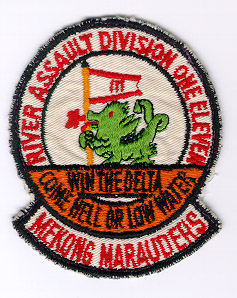By 1966 US troops had been committed in large numbers to three of the four corps areas of Vietnam. Only in IV Corps, the Mekong Delta region, were there no large numbers of American troops. This was due to three major factors. First, though the delta was a major population and food center, the military situation was not as critical as in the other corps areas. Second, due to the density of the population, there was no available tracts of land where a large military installation could be constructed without dislocating large numbers of people. And finally, the numerous rivers, streams and canals which dissected the delta severely restricted ground movement; US planners were reluctant to commit US troops to such an environment until they found a way to overcome the mobility problem.
However, in 1966, there was a strong desire on the part of the US Army to insert troops in the Mekong Delta to counter growing communist strength. In March of 1966 a joint planning committee of Army and Navy personnel drew up tentative plans for the establishment of a Mekong Delta Mobile Afloat Force (MDMAF). This proposal was further detailed during the summer, and by September plans had reached the implementation stage. On 1 September, the first administrative unit of the new organization was commissioned at the Navy Amphibious Base in Coronado, California. Shortly after this, the unit received the designation Task Force 117 (TF-117), and was code named the Mobile Riverine Force. (MRF).
As originally envisioned the MRF would support an infantry brigade and an artillery battalion using a variety of modified landing craft, support ships, and specially designed assault boats. In essence this strike unit would be, a self contained amphibious assault force, complete with all support elements except aircraft. The ideal choice for the ground component would have been the Marines who were specialists in amphibious warfare, but unfortunately the Leathernecks were already heavily committed in I Corps. Instead, a brigade from the 9th Infantry Division was chosen as the infantry component of the Mobile Riverine Force.
The Naval component of TF-117 was made up of a wide variety of ships and boats. The first unit, River Assault Squadron 9 (RAS 9), consisted of four APB's, two LST's, twenty-six ATCs, five Monitors, two CCBs, one Refueler, and sixteen ASPBs.

The small craft were equally divided between River Assault Divisions 91 and 92 (RAD 91 and RAD 92) while the support ships formed River Support Squadron 7 (RSS 7). Eventually another six divisions would be added to TF 117. Except for the ASPB which was newly designed, All these Craft were basically standard navy vessels modified for use with the MRF.
The first elements of the Mobile Riverine Force reached Vietnam on 7 January 1967 when the USS Whitfield County (LST 1169) docked at Vung Tau. Training began immediately with the 2nd Brigade of the 9th Infantry Division. This unit, in preparation for the assignment to the Mobile Riverine Force, had gotten rid of their tanks, trucks, APCs and jeeps since there would obviously be little need for them in the Mekong Delta. In addition, some of their heavier artillery was also left behind since most of the necessary fire support would be supplied by the assault boats. Unfortunately, because the initial number of barracks ships could only handle two of the brigade's three infantry battalions and artillery batteries, the remaining units had to operate out of the newly constructed shore facility at Dong Tam until the rest of TF-117's ships were available.
The major problem initially faced by the MRF was the lack of having their own vessels to train on. For the first few months TF-117 used borrowed Vietnamese Navy landing craft and control boats until its own boats began arriving. During this time, the Viet Cong carried out a number of attacks against ships on the Long Tau River. On 15 February 1967 the VC sank one US minesweeper and damaged three others. As a result of these attacks, plans were made to carry out regular search and destroy missions in the Rung Sat zone which bordered the Long Tau, even though the Mobile Riverine Force lacked their own boats. Working with Vietnamese units operations were carried out through March which resulted in a substantial drop in the attacks by the communist guerrillas. However despite these efforts the Rung Sat continued to be used by the VC and throughout the war allied forces had to periodically sweep the area to deny the enemy free access to it.

Gradually the MRF built up its strength. However, the number of boats needed to fill out the Force's prescribed strength took time to produce and deploy to Vietnam. It was not until 1968 that the full complement of 180 river assault craft was reached, but fortunately, by the summer of 1967 there were enough boats on hand to carry out sustained search and destroy missions. These boats were rather unique vessels, and with one exception, were modified landing craft (LCM-6s).
The main craft of the River Assault Squadron were armored troop carriers (ATCs) which were capable of carrying a full infantry platoon. Armed with a 20mm cannon, two .50 caliber machine guns, and two Mark 18 grenade launchers, plus various hand held weapons, the ATCs not only landed troops, but also resupplied them and provided close-in fire support during operations. Since they were expected to get within close range of enemy forces these boats were well protected with both conventional and 'stand-off' armor. This 'stand-off' or bar armor was a series of metal rods a foot or so out from the ATCs hull and upper works and was designed to detonate RPG or recoilless rifle rounds before they hit the structural armor plate. 'Stand-off armor' proved to be very effective against both hand held and crew served weapons used by the VC, and significantly reduced casualties and damage when an ATC was hit by enemy fire.

The main fire support vessel of the MRF was the Monitor. They were somewhat similar to the ATC from the stern forward to the troop deck, however, here all similarity ended. In a small open pit forward of the superstructure, an 81 mm mortar, similar to those aboard the Swift boats and Coast Guard cutters, was mounted. Forward of this a spoon shaped bow replaced the flat unloading ramp of the ATC. On this new bow was mounted a 40mm cannon (with a co-axial 50 caliber machine gun) enclosed in a turret. The 40mm was the main gun of the riverine forces and it provided a high volume of fire during landing operations. In addition, at least two Mark 18 grenade launchers were carried along with the individual weapons of the crewmen. Heavily armored, the Monitors often closed to within a few feet of the shore to provide fire support for the troops on shore.
The only boat specially constructed for use by the riverine forces was the Assault Support Patrol Boat (ASPB). In addition to providing fire support the ASPB was also designed to serve as a minesweeper and was fitted with a mine countermeasure chain drag. Lighter and faster than the Monitor, the ASPB was not as heavily armed or armored. It carried a single 20mm cannon and twin .50 caliber machine guns in two turrets, one in the bow, and one atop the superstructure. An 81mm mortar was mounted in the stern and two or more Mark 18 grenade launchers were also carried. The ASPB had a unique exhaust system which emptied out underwater making it the quietest of the riverine boats. Combined, these features allowed the ASPB to be used in a wide variety of roles. Aside from leading the river flotillas it was also employed for ambushes, patrols, special operations, reconnaissance, and escort missions. Later in the war, single or twin .50 caliber machine guns were added in stern while the forward gun turret had rocket launchers mounted on their sides. Linked to the machine guns the rocket launchers could be trained by elevating or depressing the machine guns and traversing the turret.

The final component of the riverine forces were the artillery and helicopter barges developed by the Army. Initially, it was envisioned that artillery would be put ashore to provide the necessary fire support. Very quickly it was discovered that there were few tracts of solid land in the Mekong Delta which could support artillery. To alleviate this problem an Army officer had a barge fabricated from sections of pontoons which enabled two 105 mm howitzers to fire while anchored next to the shoreline. These barges could also be beached if the tide went out and the artillery could be resighted, allowing the gun crews to keep firing their howitzers after only a slight delay. Helicopters also faced the same problems since there were few areas for them to set down. The ATC(H) provided only a partial solution, and the problem persisted. Similar to the artillery barges, a helicopter barge was developed using sections of pontoons. Each of these helicopter barges could accommodate three Hueys and were equipped with a refueling system which carried 1,500 gallons of JP-4 aviation fuel. Since neither of these barges were self-propelled, LCM-8s were used to move them for resupply of fuel and ammunition. These barges provided a quick and inexpensive solution to the problems faced by both artillery batteries and helicopter crews. As a result the MRFA did not lack for artillery or helicopter support.
Click on the link to visit this excellent site.






